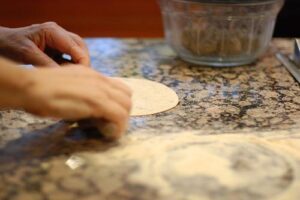by Louise Ayer and Anjuli Ayer
My Athimbair (brother-in-law in Tamil), my only protector as an American in a strange world, the only one who went out of his way to make me feel at home on this, my first trip to India, watched as I rolled a chapati. He was clearly proud of me. My chapati was a true circle and uniformly thin. As I applied pressure with my rolling pin, the chapati spun in a circle on the floured surface of the counter. “You know, Louise,” said Athimbair, smiling and patting my shoulder affectionately, “That’s the sign of a good cook. A man judges his woman by the thinness of her chapatis and whether she can make them spin.”
Chapatis, or rotis, as they are also called, are the Indian flat bread that is the staple of the North Indian diet, as rice is in the South. I had been practicing for weeks, watching and imitating my sister-in-law, Mohana, who could obviously make her chapatis spin and whose chapatis were always a uniform thinness.
India is still a place where hands have not been entirely replaced by machines or utensils. Many Indians still eat with their hands, they make bread with their hands, they wash clothes with their hands. Daily, women of the house in the south make decorations like sand paintings, called Kolam, on the ground or stone in front of their front door by mixing ground rice powder with water, which they pour deftly through their fingers in a myriad of symbolic patterns to bestow prosperity on their home.
As a family in India, we still eat with our hands. It is rare to even use a spoon. Spoons are used in cooking but not eating. Traditionally, food was served on a clean banana leaf. However, in my family, banana leaves are now reserved for those who still live in rural settings in the south; the rest of us use plates, except on certain special occasions like weddings. Each course is served in a little pile on the leaf. In the south, soup dishes such as dal are mixed with rice to a texture that can be picked up. In the north, you use chapatis to pick up your food. You tear off a piece of chapati by leaning on it with the heel of your right hand and tearing with your fingers. All this is done with the right hand only. The left hand is traditionally reserved for serving and cleaning. You then hold the piece of torn chapati between thumb and index finger, or thumb and middle finger, and use this delicious morsel as a pliable scoop to pick up your food.
Eating with your hands, the way it’s done in India, is a very interesting experience for someone born in America. For the most part, as children, we are taught not to eat with our hands, but to use our spoon or knife and fork. Unless we are very, very small, we are admonished when we pick up our peas or other little bits with our fingers. If we picked up wet food with our fingers people would look at us in horror as if to say, “What is wrong with you? We are not animals.”
Oddly enough, eating with your hands in India, even though your fingers do get soiled, requires a great deal of finesse. Generally, with great affection and attention, the women serve the children and guests first, then the men, and then themselves. The women watch those who are eating, and as they observe plates becoming empty, they thoughtfully offer more chapatis or rice, or perhaps the next course. This allows those who are eating with their hands to relax and enjoy themselves. When the eaters are content, they leave the table and retire to the bathroom to wash their hands and their mouths. Then the table is cleaned and the next group eats. The women, when it is their turn, serve each other.
The whole dining experience is definitely an art that needs to be practiced and mastered. When I first tried to eat with the grace of my family, I felt like a clumsy oaf, dropping my food, not able to convey it to my mouth with style. I felt humiliated. I wanted to crawl in a hole. I had no idea it would be so hard. But I persevered. I knew how to eat with chopsticks, and I figured that if I just kept at it, I would get there eventually.
Once I’d mastered the technique, I was able to relax, and I began to realize that the true enjoyment of this type of cuisine could only be fully appreciated if I ate with my fingers. The texture and temperature of my meal as experienced through my fingers became an extra dimension beyond flavor and aroma adding to my overall enjoyment. I felt more connected to the food I was eating, and I also felt connected and grateful to those who were serving me with so much care. It became a very satisfying experience to eat with my family using my hands.
Mohana has told me again and again how doing all these tasks such as grinding grain by pounding it by hand, making butter, making our meals from scratch, all the multitude of tasks that used to be performed by hand instead of machines produced bodies that were strong and supple without all the modern ills of back problems and hip problems and gave people a feeling of connection and pride.
From my daughter Anjuli: Like ghee, the technique for making chapatis is best seen in person. Below, I have attempted second best, giving you instructions and visuals to help guide your technique. It’s easy once you get the hang of it.
If you eat a meal with chapatis, no utensils are necessary. If you’re unfamiliar, rip off a piece of chapati, scoop up some of your subji, (vegetables sauteed in oil and seasoned with aromatics and herbs such as cilantro or curry leaves), fold it over, and pop it in your mouth. Whatever you do, eat with your hands. It’s a whole different world out there.
Chapatis
Makes 14
2 cups whole wheat flour
½ teaspoon salt
¾ cup water


Mix the flour and salt in a medium bowl. Add ½ cup of the water in a steady stream, kneading with your knuckles as you pour. You’re looking for all of the moisture to be absorbed and the dough to look moist but not wet. Add the final ¼ cup of water if needed, continuing to knead. Pick up the dough in your hand and continue kneading for 5 minutes, until it’s smooth, elastic, and neither wet, nor dry. I often walk around with the ball of dough in my hand, squeezing and transferring it from hand to hand.
Place a dab of ghee in a medium bowl and roll the dough around in it. Cover it with a moist hand towel or a plate and let it rest at room temp for at least one hour but not more than two.
Roll the dough into 14 walnut-sized balls. Place a sauté pan (cast iron would be best) on medium-low heat. Lightly flour a section of your counter (preferably stone) and pour a pile of flour onto a counter, slightly off to one side. Take a ball of dough and flatten it into a disk of uniform thickness about 2 1/2 inches in diameter. Keep the remaining balls covered with a plate or moist towel while you work.
Dip both sides of the disk gently into the flour. Using an Indian rolling pin, roll out the chapati gently, leaning a bit more on the skinny ends (see Cook’s Note). The chapati should turn naturally as you roll. Continue rolling until you can’t see any flour on the surface.

Pat the chapati into the flour again on both sides. Continue to flour and roll until the chapati is 6” in diameter and there’s no flour on the surface.
Place the chapati flat in a sauté pan preheated to medium-low heat, and cook until the edges begin to lift and bubbles begin to form, less than a minute. Turn it with a pair of tongs, and leave it for 5 to 10 seconds more.



Move the chapati directly onto a medium-high flame. Wait until it puffs up (about 5 seconds), then turn it over and give it 3 seconds more. Place the chapati on a plate and add a ¼-teaspoon dollop of ghee to the center. Rub it around on one side with the back of a spoon. Cover with a hand towel.

Repeat. Eat warm.
Cook’s Note: An Indian rolling pin can be ordered from Amazon. They are slender and tapered at each end, uniquely made for rolling out chapatis.
Variation
Methi chapati
Methi are the leaves of the fenugreek plant. You can buy them in an Indian or Asian supermarket or grow your own. You can buy organic fenugreek seeds online or from a seed company. They are easy to grow.
Methi chapatis are actually my all-time favorites. The methi changes the chapati into something exotic with a rich, slightly bitter flavor. I also like the way the methi looks peeking out from the dough. Just mix ¼ cup of minced fresh methi in with the other ingredients when you’re making the dough, and knead the same way as regular chapati.
Generally, we serve chapatis with a typical Indian chickpea dish made with spinach or onions and tomatoes. You can serve them with any subji or curry.

 Get access to the monthly Rehumanization Magazine featuring contributors from the front lines of this effort—those living on Death Row, residents of the largest women’s prison in the world, renowned ecologists, the food insecure, and veteran correctional officers alike.
Get access to the monthly Rehumanization Magazine featuring contributors from the front lines of this effort—those living on Death Row, residents of the largest women’s prison in the world, renowned ecologists, the food insecure, and veteran correctional officers alike.